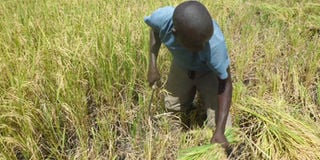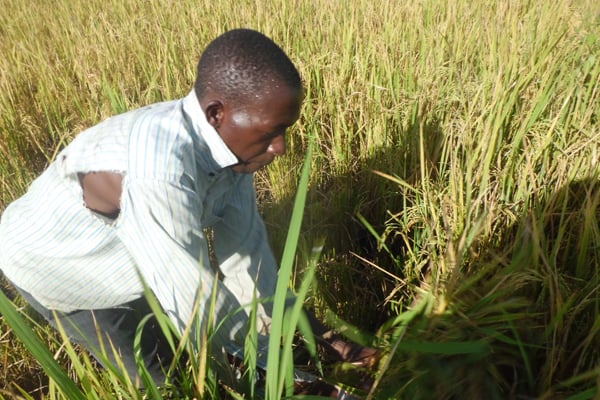New rice varieties yields more

A farmer harvests rice at Doho Irrigation Scheme. Photo / Lominda Afedraru
What you need to know:
- Promoting high yielding aromatic rice varieties alongside good agronomic practices can unlock commercial opportunities for smallholder farmers engaged in rice cultivation, given that 80 percent of rice consumers in Uganda prefer rice with good aroma.
Limited farmer access to quality seeds of improved rice varieties and knowledge gaps in good agronomic practices are the major factors limiting the crop productivity among smallholder farmers in Uganda.
Promoting high yielding aromatic rice varieties alongside good agronomic practices can unlock commercial opportunities for smallholder farmers engaged in rice cultivation, given that 80 percent of rice consumers in Uganda prefer rice with good aroma.
Background
Rice is a non-traditional crop in Uganda but it is steadily increasing in importance both as a staple food and a source of income for small holder farmers who produce more than 90 percent of the country’s rice output.
Unlike other traditional staples such as millet and sorghum grown mainly for food consumption at the farm household level, rice is considered a cash crop mainly marketed in urban markets though consumed by the rural communities as well.
As such researchers from the National Crop Resources Research Institute (NaCRRI) under the rice programme have teamed up with the Korea Programme on International Agriculture (KOPIA) at the National Crop Research Laboratories in Kawanda to conduct farmer-led uptake of improved rice seed in a bid for the farmers to realise high yields.
Seeds of Gold caught up with the scientists to explain the modalities of the exercise and below are the details.
Improved rice seed
Dr Simon Alibu, a rice breeder at NaCRRI, explained that his team in 2020 went on ground in Doho Rice Scheme in Butalejja District to establish how farmers engaged in rice growing are conducting their farming activity in a bid to analyse the current trends.
To ensure farmers take up some of the newly released varieties namely Naro Rice1 which is highly yielding and aromatic, the scientists embarked on sensitisation exercise for massive seed production for farmer uptake in rice growing regions.
Field study
Doho rice scheme lies at an altitude of 1100–1220 metre above sea level. It is formerly known as a seasonal wetland on the river Manafwa which has become an intensive rice scheme covering more than 10,000 farmers growing rice on 2,500 hectares of land under irrigated technology.
The Doho rice Scheme Farmers’ Cooperative Society (DIFACOS) is the umbrella body managing the scheme at farm level.
The project supported a few selected farmers with the seed of a new aromatic rice variety, Naro Rice1 and equipped them with agronomic skills to raise their yields from an average of 3.1 to 4.1 tonnes per hectare. This is because the researchers realised raising the seedlings in beds and transplanting the three-week-old rice plants is a crucial technology to increase rice yields among smallholder farmers.
Rice varieties evaluated
According to Dr Jimmy Lamo of Naro, the varieties evaluated included Wita9, Naro Rice1, KAFACI287 and KAFACI-167.
Naro Rice 1 is adapted to the irrigated and rain fed lowland rice ecosystems and it matures in 95 days while Wita9 on the other hand, is commonly grown in the Doho rice scheme because it is high yielding and resistant to Rice Yellow Mottle Virus disease and other common diseases of lowland rice.
It matures in 120 days therefore in this evaluation exercise Wita9 was used as a local measure. KAFACI-167 and KAFACI-287 are newly bred and are in the advanced variety testing stages. Some of the unique attributes of KAFACI-167 and KAFACI-287 include aroma, large grain size and tolerance to the significant diseases of lowland rice in Uganda.
Agronomy case study
The farmer fields were ploughed twice and puddled using hand hoes before levelling using heavy and flat wooden planks drawn on the wet soil surface using ropes. A pesticide known as Furadan 5G was then applied to the fields before transplanting rice to control apple snails known to eat up young, freshly transplanted rice seedlings.
Three-week-old rice seedlings were then transplanted into the fields at a spacing of 30 cm by 14 cm to give an average plant stand of 24 hills per square metre. The seedlings were raised by the host farmer in a wet-bed nursery in the farmer demonstration field using seeds provided by the project. After transplanting, the fields were kept wet without flooding for 10 days to keep out snails and enable the rice seedlings to establish roots without being washed away.
Controlled flooding of the fields was then implemented from 11 days after transplanting and maintenance of the water level at 10–15 cm above the ground to control weeds is followed,
The rice was hand-weeded using hand hoes at three and six weeks of growth. The farmers applied NPK fertiliser to the fields at 60 kilogrammes per hectare after ploughing while another 30 kilogrammes two months after transplanting. In both cases, we hand broadcasted the fertiliser, making sure that it is uniformly spread in the trial area.
Three weeks before harvest, the fields were drained to allow for uniform maturity of the varieties. Out of the 40 smallholder farmers that received seed and technical support from the project the team interviewed 22, representing 55 percent.
Out of those interviewed, 82 percent were male, while 18 percent were female; 41 percent of the respondents were youth and they rated rice as number one commercial rice production in the Butalejja region.
Production
The experts giving the production rate note that Uganda’s projected domestic milled-rice production currently is 228,000 metric tonnes per annum which is considered inadequate to feed the growing Ugandan population as well as meet the export demand.
Challenges
The scientists have advised farmers to follow proper agronomy practices to obtain high yields.
However despite the good news in the project trial process farmers expressed challenges which include high cost and shortage of inputs, inadequate water for irrigation water, pests and diseases, limited mechanisation of rice farming and limited farmer access to finance.




